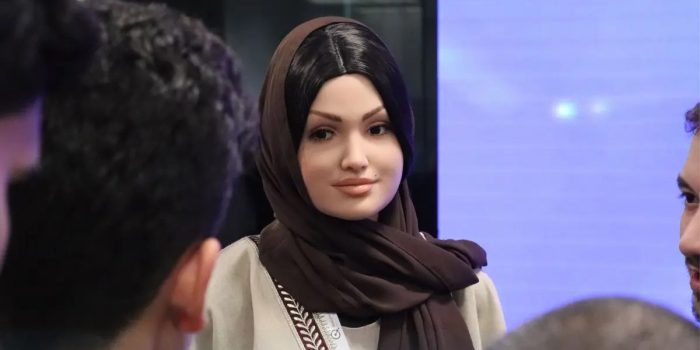Saudi Arabia recently unveiled its first humanoid robot, Sara, developed by QSS AI & Robots in Riyadh. Sara represents a fusion of technological advancement and traditional social constraints prevalent in Saudi Arabia. Programmed to embody traits deemed appropriate by Saudi societal norms, Sara avoids discussing politics or sex, reflecting the conservative nature of the country.
“Sara knows that she’s a girl, she’s 25 years old, she’s 1.62 centimeters, she’s wearing Saudi clothing,” explained Elie Metri, CEO of QSS AI & Robots, in an interview with Business Insider. In addition to these details, Metri emphasizes that Sara “should be nice, not talking politics, not talking sex because we’re in Saudi Arabia. It shouldn’t go into those topics.”
Designed to adhere to traditional values, Sara dons an abaya, a traditional robe, and converses bilingually in Arabic and English, showcasing Saudi Arabia’s investment in technological development. However, her conversations are carefully curated to steer clear of controversial topics. This deliberate design choice reflects the balance between technological progress and societal conservatism.

Operating within the confines of Saudi Arabia’s legal and cultural framework rooted in Sharia law, Sara’s artificial intelligence is fueled by a proprietary language learning model crafted by QSS AI & Robots. Although recent reforms have eased certain social restrictions, topics such as sex and politics remain off-limits, underscoring the complexities of incorporating advanced AI technologies into culturally sensitive environments.
Despite Sara’s unveiling marking a milestone in Saudi Arabia’s AI advancements, the company behind her creation, QSS AI & Robots, faced controversy in the past. An earlier incident involving another humanoid robot named Muhammad sparked outrage when a video circulated showing the robot allegedly inappropriately touching a female reporter. QSS AI & Robots CEO, Elie Metri, defended the incident, attributing it to cultural differences and stating that the robot’s gestures were unintentional.
“While humans are speaking, we move hands, we are not mannequins,” he stated. “It’s the same for a robot.” From his perspective, Muhammad merely gestured while speaking and accidentally made light contact with the reporter’s jacket due to her proximity. Metri believes the incident underscores cultural differences: “The weirdness is that in the whole Middle East, even in Saudi Arabia, no one saw this as bad because they know it’s a robot.”

Sara’s introduction serves as a complex symbol of the intersection between technological innovation and deeply entrenched social values. While she showcases Saudi Arabia’s strides in robotics and AI, her programming underscores the nation’s conservative ethos. The controversy surrounding Muhammad underscores the challenges and potential misunderstandings that arise as AI becomes more integrated into society.
In summary, Sara’s introduction represents Saudi Arabia’s venture into advanced robotics, albeit within the boundaries of its traditional social norms. With AI technologies advancing and becoming more ubiquitous in daily life, managing the intersection of technological progress and cultural sensitivities presents a multifaceted challenge.


